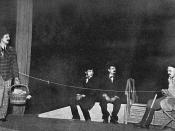At Face value waiting for Godot could be called a simple play. It uses a basic setting consisting of a tree and a road; it is repetitive in its structure and character pairing. It is an uncomplicated play with no established plot, at face value Waiting for Godot could be described as a play about nothing. The substance of Waiting for Godot lies within the ideas and themes of the play, behind this front of simplicity and nothingness. It is a question which has never ceased to pervade mankind; the meaning of life.
A very simplistic setting is used in Waiting for Godot. We know very little about the setting, the time and geographic whereabouts is completely unknown. Although Beckett makes the viewer consciously aware of two components in the setting, the tree and the road. These are the only pieces of evidence Beckett gives us to he whereabouts of the setting, but it's ambiguity is irrelevant as this simple setting has symbolic significance within the play and alludes to deeper aspects of life.
The tree and the road create two axis, vertical and horizontal. The road offers possibility of physically movement away, a horizontal transcendence. They can walk this path to find their own enlightenment or let enlightenment come to them, Godot. The tree is what keeps them rooted; it represents practicality and the physical realm. What are present here and now, a perception of reality? It represents an opportunity for growth and development of one's own self and room for spiritual enlightenment, a freedom from conventional (or rejection of conventional) of values and organised religion. To encompass a sense of self and being. The tree is symbolic of tension and confliction, as is shown in the characters Vladimir and Estragon's exchange: "Lets go": "We can't we're waiting...



A bit disappointed
The essay was repeated twice within the composition. I actually thought this essay would be over 2000 words :(
2 out of 2 people found this comment useful.